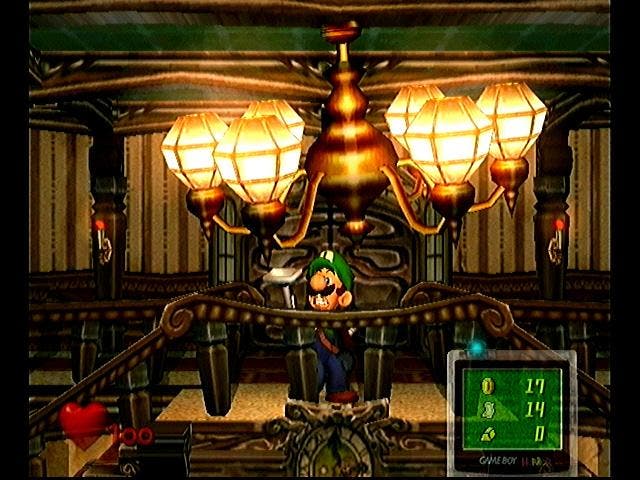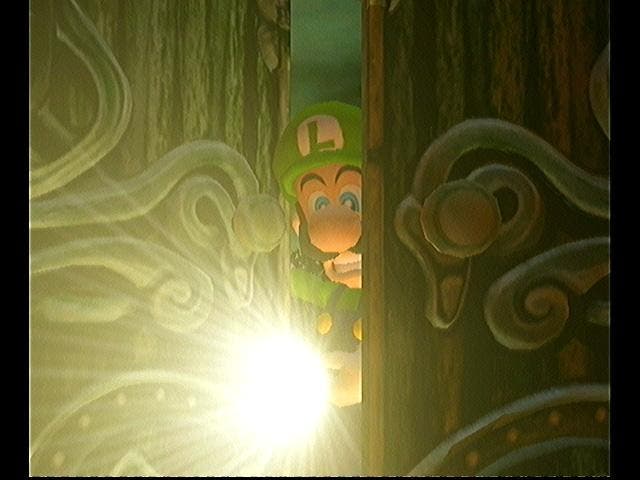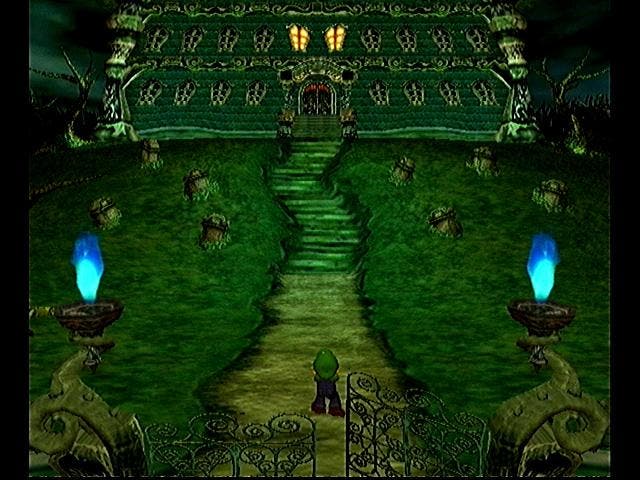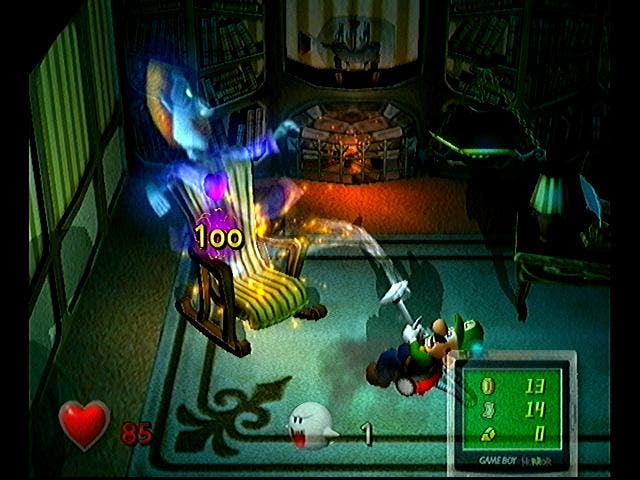Luigi's Mansion
Preview - the GameCube's first jewel in the crown? We go hands on with Luigi in his first noteworthy outing for years

Welcome to the house of fun
It seems that even when poor Luigi gets a break, he ends up having the sand kicked in his face. It's just his luck - he inherits a beautiful mansion in a scenic area on the edge of a forest and it turns out that the darn thing is haunted. Luigi is nothing if not brave, though. Upon stepping into the mansion, he is set upon by a horde of spectral squatters, but before he has time to react a wily old professor with a vacuum cleaner and a flashlight locks onto the ghosts and sucks them into his backpack. It turns out that the mansion has been haunted for some time, and this kind fellow has a mind to do something about it. It also emerges that if Luigi can capture the ghosts using his vacuum cleaner, the prof. can trap them in a painting. With the ghosts gone, Luigi can finally live out a life of comfort in his new prize. So he sets off. If you can imagine a cross between Super Mario 64 and Ghostbusters, you've got a pretty good idea of what to expect. Luigi looks like a souped-up, marginally taller version of Mario from said game, and his little red vacuum looks like one of those portable Dysons. The attention to detail is quite something - you can even see his little thumb, trembling with fright, moving the switch on his torch between on and off.

Through the keyhole
Although Luigi's Mansion is ostensibly three dimensional, when navigating the corridors the camera slides off to the plumber's side and affects a two dimensional, side-scrolling platform style. Luigi can move in and out of the screen (for instance if a corridor heads off towards another one further up the screen), flashing his torch on ghostly bats and rats before he vacuums them into his backpack, and occasionally meeting a full-blown apparition, but gone is the shackling third person approach. Throughout the game the camera is generally fixed to a wall. As Luigi works his way through the house he uses many items, the most important of which is probably his torch. He needs this to carve his way through the dark, dank corridors of his haunted mansion, and more importantly to startle the ghosts. Once startled, he can start to vacuum them up with his little Dyson wannabe. As he works his way through the mansion collecting keys, coins and jewels from departed ghosts, he turns to his Game Boy Horror to stop himself getting lost. The GBH functions as a mapping device, keeping track of the layout of the rooms he's explored and the doors in the mansion. Ground he has covered is lit up while others areas are darkened. The house is several storeys high, and these can be navigated on the map using the D-pad. Not all of the rooms in the Mansion are available to Luigi straight off. Some are locked; some are even covered in barbed wire! If you try a locked door, the screen flicks to a close up of Luigi trying the handle. It won't budge unfortunately, and more often than not will take issue with his trying the handle and fling itself open as he withdraws, pinning our hero against the wall for him to flutter to the ground comically before picking himself up again, a few health points worse off.

Don't cross the beams
When Luigi finds an open door or unlocks a new room, the fun begins. At first, everything is dark, so Luigi flicks on his torch. Various objects litter the floor and walls, and Luigi vacuums these to try and oust whatever foul spirits lurk within. In one room, a chest of drawers rattles innocently in the wind. Reaching for his vacuum, little Luigi sucks menacingly at it, until the top drawer flies open and out leaps a ghost. He quickly flicks on his torch to startle it, sees the reaction then grabs the vacuum again and sweeps around and around the room Ghostbusters style trying to suck it into his backpack. Each ghost has a certain amount of health points, and once Luigi has been sucking it for long enough that these have depleted it gives up and disappears into the backpack. If it was the last ghost in the room, the lights come on and keys and other treasures are revealed. Often vanquishing ghosts from a room results in the discovery of a key, or a concealed door or something along those lines. After clearing an entire floor, the final ghost that Luigi chances upon is often a boss of sorts. These apparitions have a lot more health points than the average spectre, and attack you in patterns using whatever means are available to them. In one encounter, the ghost of a baby slings rocking horses and beach balls at you, and immune to your flashlight you must suck up these beach balls and sling them back at him using reverse suction. Only then can you start bringing him down. After a while spinning around trying to suck the ghosts into his backpack, Luigi gets dizzy and loses concentration, and has to wait for the next opportunity to attack the ghosts.

Busting at the seams
The whole approach is very varied and rewarding. As we worked our way through an entire floor we came across all manner of ghosts and each put on its own display of resistance. In one room - the bathroom - a huge shower curtain flapped innocently in the wind, behind which our enemies prowled. The effects used on table cloths, curtains and other sort of fabrics flapping in the wind are very realistic. Tables, chests of drawers, cupboards, pipes, barrels - the designers have dressed up the game nicely. The ghosts look foggy and extremely ghoulish, taking the effects used in Mario games to the next level. They are eerily reminiscent of those seen in Ghostbusters the movie, too. The most intriguing aspect of the game though is the control system. The left analogue stick controls the direction you walk, while the C-stick on the right controls the direction Luigi faces. It's actually possible to run one way down a corridor while facing the other. The left and right shoulder buttons blow and suck respectively, while the B button toggles the flashlight off and on, leaving the A button for opening doors and other functions. When it comes to trapping a ghost, Luigi first toggles on the flashlight by releasing the B button and startling it, then grabs the right shoulder button to switch on the vaccuum. At this point, the ghost starts to fly around the room frantically, and by rotating the left and right analogue sticks fast Luigi is able to keep track of it. When he hits an object or loses the trail the ghost vanishes and must be uncovered again. Invariably this involves switching off the torch and turning away into the dark…
Conclusion
Luigi's Mansion is likely to be one of the most popular early GameCube games, and if it stays fresh throughout its many rooms and hallways, it may help the hapless plumber win himself a few more notable outings in the next year or two. Our only concern is that capturing ghosts in room after room could lose its appeal after a while. With only one location to explore, it'll have to jump through some pretty spectacular hoops the further we venture in. We hope to learn more when the console launches for real in two weeks' time.
-


.png?width=291&height=164&fit=crop&quality=80&format=jpg&auto=webp)




.jpg?width=291&height=164&fit=crop&quality=80&format=jpg&auto=webp)
